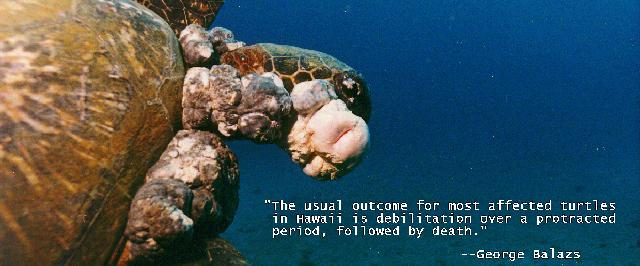

Peter and I wish to extend our warmest aloha to the team of 22 researchers who’ll be visiting Honlab this week.
We are sending this communication along for some friends of ours who really can’t speak for themselves. They are a community of Hawaiian green sea turtles who struggle daily with the burden of fibropapilloma. If they could speak, they would be most grateful to you for working so hard on behalf of all sea turtles threatened by this disease.
We don’t just offer thanks, however. We know you are all committed to finding an answer, so this isn’t a pep talk. You don’t need one. (Besides, any "pep talk" we could offer would be depressing.)
We simply wish to share images of three turtles with fibropapilloma. All of you will have seen more horrible examples than these three. We selected them because they are good friends who began showing the symptoms of FP last summer--1997.
The goal of your workshop, according to George Balazs, is "to provide expert guidance on directions that fibropapilloma research should take over the next five years or until the disease is resolved."
That’s why we chose the first two turtles. They just might have five years left in them.
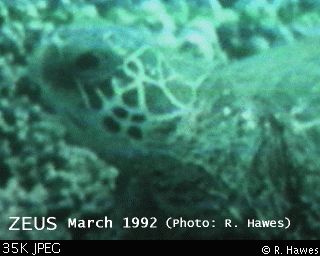
| Zeus, known to us since 1993, was photographed by Rob Hawes at Honokowai in 1992. |
This is Zeus. We have known him since 1993. The first photo was taken by a diver who saw Zeus before we ever did. Rob Hawes dived our area in March 1992. With this image, Rob proved Zeus has been at Honokowai for at least that long. We first sighted Zeus in July of 1993 and have seen him every summer since. He is the biggest turtle we’ve ever met. We think he's also the oldest. For all his size, he is gentle and shy.
This summer, Zeus had tumors in both eyes. | 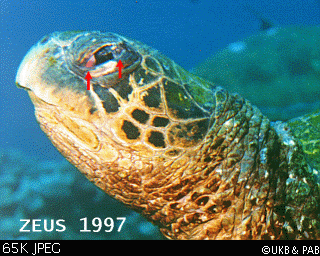
|
This summer, we saw our old friend on our very first dive. Right away we saw the signs of fibropapilloma. The tumors were there in both his eyes.
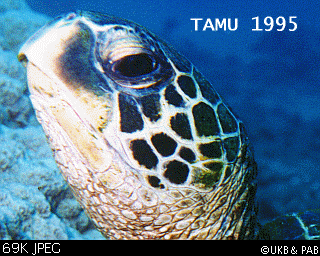
| Tamu, known to us since 1995. |
This is Tamu (named after Texas A&M University), We first sighted this turtle in 1995. Tamu has been a regular in the Honokowai ocean ever since.
We saw Tamu again in 1997. Over the ten months since we’d last seen this turtle, Tamu had sprouted the long tail of a male honu. Tamu also had something else that had grown since the last summer. His eyes stared back at us with small tumors growing in them. He now has FP.
This summer, Tamu had new tumors in his eyes and mouth. | 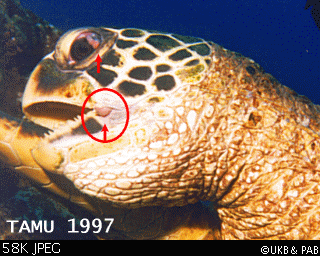
|
Sadly, when Tamu opens his mouth, there is a small tumor growing out the left corner. As you know, in just two years this tumor can grow large enough to choke off our good friend’s feeding and breathing.
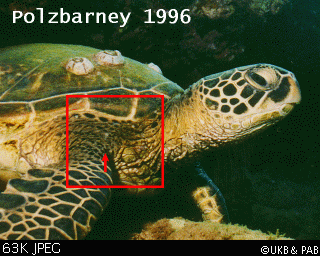
| Polzbarney, known to us since 1995. |
The last turtle is Polzbarney, named after Paul C., who like us, visits Honokowai every summer. For the two weeks he’s there, Paul snorkels out two or three times each day to be with his honu friend. Hence the name: Paul’s barn-acled turtle. We have known Polzbarney since 1995 and she (he?) lives in 12 feet of water under a favourite ledge. Already by 1996 we were worried about this little honu.
This summer, Polzbarney had hints of tumors on his right shoulder. | 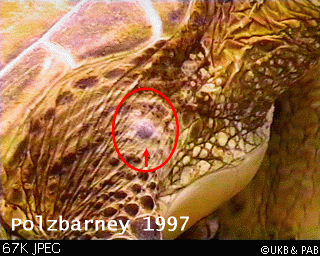
|
This summer, the turtle had the very smallest hint of tumors growing from the right shoulder. Nothing much bigger than the cotton swab from a Q-tip, still... Polzbarney is a youngster and that spells doom. As far as we can tell, no recruit or young turtle has ever survived FP at our dive site. Most youngsters "disappear" two or three years after showing symptoms.
We don’t believe Polzbarney has five years.
This year Paul anxiously mentioned the spots on his good friend. We did not hold back the likely fate of this turtle. The man’s eyes were grim as we told him what lay ahead. Every summer, as we came out the water, he’d ask about what we’d seen. He’d listen intently and be concerned.
Now that his friend has the disease, he has been deeply moved. He has yet to feel the helplessness and despair we’ve experienced over the years. Unfortunately, that too is in store for him, and he’s been warned.
(Told you we’re no good at pep talks…)
To us, (people who care very much about individual turtles), your week in Honolulu is as important as any summit conference. These next four days are critical in the lives of the turtles we have come to know so well. That’s what we wanted to tell you.
Last, we want to thank George Balazs for the expertise and dedication he directs towards Hawaii’s honu, and especially for hosting this workshop. We wish all of you a successful week and safe flights home.
Aloha nui loa,
Ursula Keuper-Bennett
Peter Bennett
(SCUBA divers/sea turtle enthusiasts)
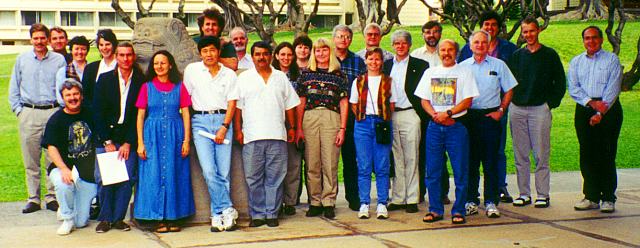
Back row (L to R): Herbst, Ehrhart, Landsberg, Quackenbush, Pooley, Lutz, Teas, MacPherson, Docherty, Morris, Spraker, Aguirre, Work, Klein
Front row (L to R): Balazs, Dutoit, Chavez, Lu, Vasconcelos, Moore, Schroeder, Bolten, Jacobson, Harshbarger
Missing: Swimmer, Zamzow
Photo courtesy G. Balazs